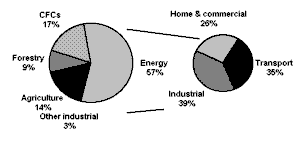 Introduction
Introduction Introduction
IntroductionThe world needs the greenhouse effect. Without it, the planet would be around 30 deg. C (degrees Celsius) colder than it is at present.
Greenhouse gases found naturally in the atmosphere, such as carbon dioxide and water vapour, allow energy from the sun to pass down through the atmosphere unhindered but trap heat radiated by the surface of the planet before it can leave the lower levels of the atmosphere.
Global warming is a problem because humanity is releasing greenhouse gases into the atmosphere at an ever-increasing rate and destroying the natural processes that remove greenhouse gases from the atmosphere. The result is that the greenhouse effect has become stronger.
The major greenhouse gases are carbon dioxide, methane, the halocarbons (including the chlorofluorocarbons or CFCs) and nitrous oxide.
Of the major greenhouse gases, carbon dioxide accounts for over half the strengthening of the greenhouse effect at present, methane accounts for around a sixth, the halocarbons a tenth and nitrous oxide a few percent. Other miscellaneous gases, including surface ozone, account for the remainder.

Sources of the greenhouse gases in terms of their contribution
to global warming during the 1980s.
World-wide, the production of energy from fossil fuels - coal, gas and oil - is the major single source of greenhouse gases.
The burning of coal, gas and oil is the dominant form of commercial energy production. Close to 85% of the energy generated commercially for use by industry, in the provision of heating, cooling and lighting and for transportation is provided by these fuels.
During the 1980s, energy generation was responsible for over half of the global warming problem. In 1990, the burning of fossil fuels released about six thousand million tonnes of carbon into the atmosphere, as well as other greenhouse gases such as methane and nitrous oxide and the pollutants which generate ozone.
The other major source of greenhouse gases is agriculture, forestry and related land-use activities. These account for close to a quarter of the global warming problem, releasing a range of gases including methane, nitrous oxide and carbon dioxide into the atmosphere.
Changing land use - for example, the conversion of forest into cropland or pasture - is responsible for the release of between one and two thousand million tonnes of carbon a year world-wide. Most emissions are the result of deforestation.
Changing land use represents Vietnam's main contribution to global warming. Land-use change in Vietnam released ten times as much carbon into the atmosphere as did energy production during the late 1980s.
Other forms of agricultural activity also release greenhouse gases into the atmosphere. Methane, for example, is produced in the digestive systems of herbivores such as beef cattle, dairy cows, goats and sheep. It is also produced by organic decomposition in water-logged areas such as paddy fields. World-wide, rice production may be responsible for as much as a fifth of the methane released into the atmosphere (although there are uncertainties regarding this estimate).
The main activities giving rise to greenhouse gas emissions - energy generation and the development of industry and agriculture - are activities that are fundamental to the historical process of economic growth through industrialization.
Does this mean that industrialization need be inherently damaging? According to Dr Ha Nghiep, Assistant to the General Secretary of the Communist Party of Vietnam, "it is necessary to combine economic development with the healthy development of the environment."
It is the particular model of economic growth pioneered by the northern nations that is unsustainable, containing within itself the mechanism of its own destruction.
 "Introduction: Responsibility for Global Warming"
"Introduction: Responsibility for Global Warming" Index
Index